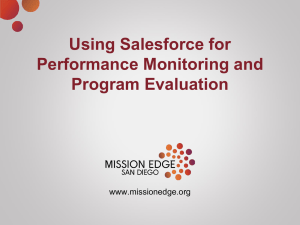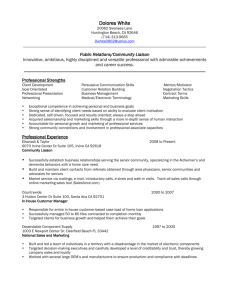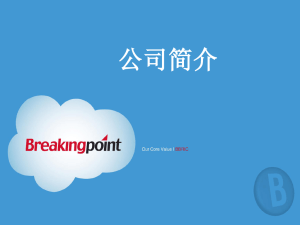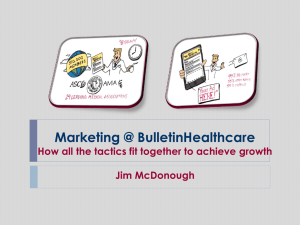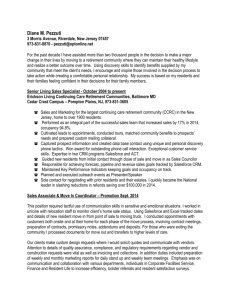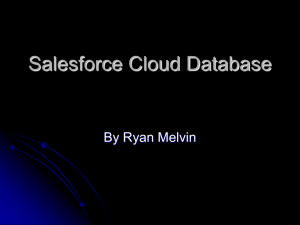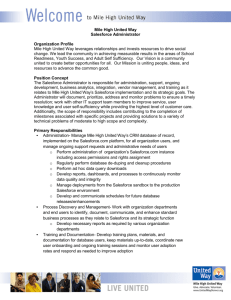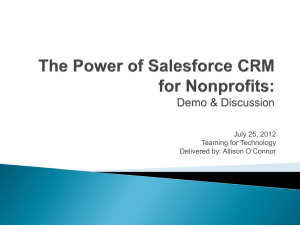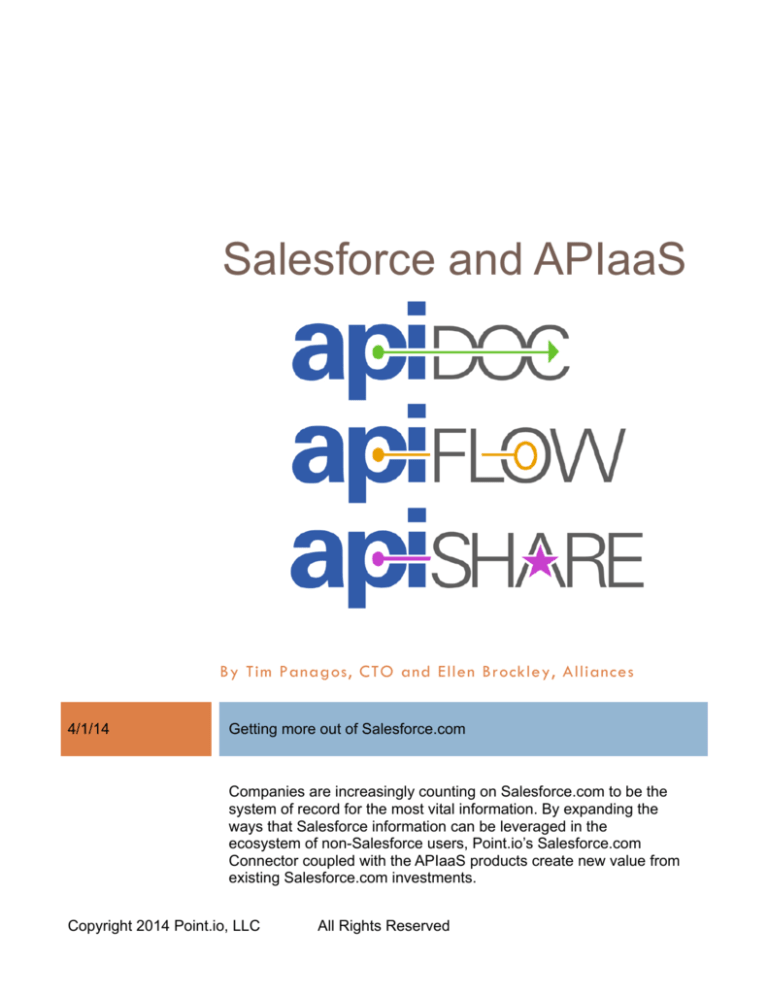
Salesforce and APIaaS
By Tim Panagos, CTO and Ellen Brockley, Alliances
4/1/14
Getting more out of Salesforce.com
Companies are increasingly counting on Salesforce.com to be the
system of record for the most vital information. By expanding the
ways that Salesforce information can be leveraged in the
ecosystem of non-Salesforce users, Point.io’s Salesforce.com
Connector coupled with the APIaaS products create new value from
existing Salesforce.com investments.
Copyright 2014 Point.io, LLC
All Rights Reserved
Salesforce and APIaaS
WHY SALESFORCE AND API AS A SERVICE?
Point.io offers the industry’s first API-as-a-Service product that allows organizations
£ to extend their investments in Salesforce.com,
£ to create simpler experiences for casual users,
£ to monetize leads by engaging channel partners seamlessly, and
£ to keep customers engaged by giving them control of the buying process.
All of this is possible without costly custom integration or jeopardizing the safety of the
Salesforce system of record. This whitepaper will tell you more about this powerful opportunity
to get more from your existing Salesforce investment using API-as-a-Service and Point.io.
WHAT IS API AS A SERVICE?
Applications programming interfaces, or APIs, are the lingua franca of the modern mobile/web
architecture--supporting web, mobile handsets, and the expanding cadre of Internet of things
participants from smart TVs to wearable devices. By leveraging APIs today, businesses can
achieve immediate benefit from engaging their ever-more-mobile stakeholders in critical
business tasks with zero friction.
API as a Service is a fully managed solution that allows an organization to expose select
information assets through web-facing APIs. Fully managed means pre-built, pre-hosted, and
pre-integrated--in other words, turnkey. When combined with high-value data sources like
Salesforce.com, APIaaS can become a new channel—creating new revenue, making better
use of channel information, and satisfying customers to ensure return business.
1
Copyright 2014 Point.io, LLC
All Rights Reserved
Salesforce and APIaaS
Developers use APIs to very quickly deploy new apps that can exploit underutilized digital
assets of an organization in a myriad of ways.
£ Sell access to proprietary information,
£ Attract and retain paying customers,
£ Orchestrate sales with channel partners, and
£ Create new, specialized product offerings to name a few.
As an API-as-a-Service vendor, Point.io is a fully managed solution that allows an organization
to expose select information assets through web facing or APIs. With proprietary connectors to
the major cloud and on-prem data storage providers as well as enterprise BPM and CRM
systems, Point.io allows you to access and combine data from any legacy or cloud system
through a set of simple API calls. You can improve internal efficiency, expand capabilities to
customers and realize new revenue streams from leveraging valuable information stored in
your data.
SALESFORCE.COM AS API
No function is more critical to business then the sales and finance processes that bring in
revenue. Salesforce.com is increasingly trusted by businesses from sole proprietorships to
large enterprises for the stewardship of the data and processing necessary to support these
most critical functions. Point.io’s most celebrated connectivity option is the Salesforce.com
Connector because the domain represented by Salesforce is surely valued and the opportunity
implicit in getting more out of the information is undoubtedly huge.
Our Salesforce.com Connector allows you to connect Salesforce data objects, Salesforce
Files, and reports without installing new software or engaging in a costly custom integration
project. Once connected, each member of the Point.io family of APIs can yield unique new
returns from the existing assets. APIdoc allows for unparalleled connectivity for exchange of
file and file-like objects. APIshare allows seamless sharing of Salesforce information via data
or document to maximize internal and external collaboration. APIflow provides structured
processes that ensure that data is always up-to-date and valid while automating new client
acquisition and onboarding operations.
All of Point.io’s API products support all popular programming languages and execution
environments. From on-premise mainframes to cloud-based SaaS to BYOD mobile devices,
our APIs ensure interoperability with each other and with Salesforce information. Most of these
applications will require only a single, dedicated Salesforce Enterprise user account rather
than the hundreds that are often provisioned to support casual interactions.
2
Copyright 2014 Point.io, LLC
All Rights Reserved
Salesforce and APIaaS
SALESFORCE APIDOC FEATURES
The APIdoc with Salesforce.com Connector allows you to connect your Salesforce Files
content to an API proven to speed deployment of file-based assets to a variety of API-enabled
channels including: web, mobile, and social applications. APIdoc support all file types and any
foldering structure to allow you to publish content in any format without restructuring existing
file organization schemes.
The APIdoc with Salesforce.com Connector also allows you to connect your Salesforce Report
content as if they were static documents in Salesforce Files. Instead of providing access to
static data, however, the report connector option allows you see expose always-current, views
on any of your Salesforce data both in detail and in summary. You control the format by
exposing out of the box reports or by creating new reports for special purposes. Reports can
be viewed through APIdoc as either CSV data or as Excel spreadsheets (XLSX) to satisfy a
variety of end-user needs. And with APIdoc, you can always choose to expose documents as
PDF files to share the information without losing control of the content.
Internal Use Case: Salesforce inside SharePoint
It is a common requirement for organizations to combine static content from repositories like
Microsoft’s SharePoint with dynamic content like Salesforce reports. Imagine providing your
employees with a single source for account information that includes the most current sales
data from Salesforce.com, current proposals and marketing material from MS SharePoint, and
historical proposals and signed contracts from Documentum and FileNet. Being able to see all
relevant information through a single interface will eliminate manual steps and confusion when
each department chooses a different storage solution.
External Use Case: Monetizing Unpursued Leads
Every company has collected leads that fall below the threshold for pursuit by internal sales-perhaps the expected dollar amount is too small or the risk of non-payment is too high--and
typically these leads simply age in Salesforce.com. Using APIdoc, one company has exposed
these unmonetized leads through an API to a bidding system that allows competitors to pay
them for their unused leads. General data about the lead is visible to all and winning bidders
get exclusive access to the demographic data needed to pursue. With this APIaaS solution, the
company is expecting an eight-figure profit from previously worthless data.
3
Copyright 2014 Point.io, LLC
All Rights Reserved
Salesforce and APIaaS
SALESFORCE APISHARE FEATURES
There are many use-cases for sharing of Salesforce content. Salesforce is becoming more and
more important to organizations who are leveraging the platform as the system of record for
more and more data. The APIshare product combined with the Salesforce.com Connector
allows common applications to exchange Salesforce information easily without requiring
Salesforce user licenses for each share participant. Spread information broadly without the
administrative overhead, data security risks, or unnecessary fees associated with maintaining
user accounts for casual data consumers.
APIshare when coupled with the Salesforce Connector allows for the automation of report data
sharing for any report--out of the box or custom built, detail or summary--that is defined within
Salesforce. Leverage existing skills to publish more specific reports that give each user
population just the data that they need. Reports shared through APIshare can be made to
appear as CSV data, MS Excel spreadsheets, or the highly transportable PDF file format.
You control how users interact with your data. Share all of your reports, just a select few with a
report sub-folder, or a specific report. Share with dynamic data--always the latest whenever the
file is opened--or share snapshots of static data for a single, source of truth.
Leverage other features of APIshare to provide a unique combination view that features
Salesforce Files or dynamic reports mingled with static files from any of the APIdoc supported
storage sources to see custom data room for a given account. Imagine collaborating on current
Salesforce data, past signed contracts, shared marketing material, and any sales proposals inflight with an account team all without copying the files.
APIshare features capabilities to allow sharing with semi-trusted third-parties using advanced
DRM features that allow you to control how the recipient interacts with the Salesforce report
that you are sharing. You can control whether they can print, download a PDF, or forward the
report to another person. And see what actions have been taken at each step of the way. Full
management, visibility, and control.
Internal Use Case: Report Distribution
Within Salesforce, a licensed user can run a report and share the output manually with a
number of people by by manually creating a spreadsheet and attaching it to an email for
distribution. This works for small, ad-hoc requests but can become labor intensive. Many
companies have resorted to either assigning Salesforce accounts to data consumers or to
hiring full-time report distributors. APIshare coupled with the Salesforce Connector allows an
4
Copyright 2014 Point.io, LLC
All Rights Reserved
Salesforce and APIaaS
administrator to simply email shared links to existing reports to stakeholders. The reports are
automatically run, transformed, and presented through mobile apps or desktop browser when
the link recipients click the link. And it works with only one API-enabled Salesforce Enterprise
account.
External Use Case: Proposals to Channel Partners
When inside sales creates specific proposals for prospects, they often send those proposals to
channel partners for delivery and enrichment. Many companies utilize channel partners that
may also rep competitive products and services. Using the APIshare product, one manufacture
stopped emailing proposal material to channel partners and chose to share information in a
way that dissuaded them from “shopping” proposal details with competitive manufacturers. By
limiting the ability to copy content and forward documents, the company is capturing more
sales through their channel.
SALESFORCE APIFLOW FEATURES
APIflow is the API product that allows organizations to externalize core business processes-automating common functions, structuring collaborations with customer and partners, and
extending the reach of systems of record beyond corporate boundaries. When coupled with
the Salesforce.com Connector, APIflow puts the power of structured processes to work on your
most valuable data.
APIflow and Salesforce.com Connector together can allow you to integrate all of the
Salesforce Objects--out of the box or customized--with your custom workflows for approval,
sign-off, or data enrichment. An APIflow workflow may automate the creation of new records,
the review of existing content, and the updates of critical account information within the
controlled environment of a structured process. Get audit history for record updates with who,
what, when, where, and why information. Protect significant data updates with configurable
approvals to avoid data corruption and inadvertent data loss.
Get immediate value with APIflow by leveraging preconfigured workflows that work seamlessly
with both Salesforce data objects and Salesforce reports for common enterprise activities like
approvals, signing, and error handling. Eliminate the hassles of missing or incorrect data due
to validation errors, duplicate information, and unauthorized edits. You get full visibility, control,
and governance of your Salesforce data.
5
Copyright 2014 Point.io, LLC
All Rights Reserved
Salesforce and APIaaS
Internal Use Case: Quarterly Account Data Refresh
Salesforce data is invaluable when it remains accurate. Can your finance department depend
on the contact details for processing of invoices? Quarterly reviews of key contact information
is a best-practice but it can be time consuming and expensive if each participant requires their
own Salesforce account in order to perform the data review. With APIflow and the
Salesforce.com Connector, a process can be automatically triggered quarterly which forwards
a task to each account manager. Tasks can display, collect changes, and update records
based on a timed, structured process conducted outside of Salesforce.com.
External Use Case: Sync Data between Multiple Orgs
Branch and home-office, channel and manufacturer, there are many situations where sales
data must be both separated and kept in sync around multiple orgs within Salesforce.com.
Current solutions are costly and error prone. The challenge is not just to move data, but to
handle the inevitable exceptions that result from small differences in data structure and user
permissions across many Salesforce.com installs. To accomplish this, APIflow uses a
structured process to move updated data back and forth between accounts and, more
importantly, reach out when data collisions occur so that important updates are not lost.
CONCLUSION
Salesforce.com is a critical system of record for an increasing number of companies; large and
small. By wrapping a Salesforce implementation with standard APIs, any company can get
more for their Salesforce investments by collaborating more efficiently with employees,
customers, and partners without degrading data quality or opening up sensitive data to attack.
APIdoc, APIflow, and APIshare are the API products that when combined with the
Salesforce.com Connector give Salesforce users the maximum benefits from their investment.
By expanding the reach of critical data beyond the classic Salesforce user to additional
departments, extended channel participants, and prospects themselves; Point.io makes
collaboration affordable and efficient to get sales done faster.
6
Copyright 2014 Point.io, LLC
All Rights Reserved
Salesforce and APIaaS
ABOUT POINT.IO
Point.io is a Patent Pending API-as-a-Service Platform that enables organizations to monetize
existing digital assets and join the API Economy. Using the Point.io API products, IT executives
can dramatically reduce development time for API-enabled applications, and therefore realize
significant cost savings and faster time to market. Business leaders can explore new business
models that leverage existing information assets to generate new revenue while resting
assured that data access patterns comply with corporate policy because Point.io authenticates
every access request and monitors all activity. Point.io's technology delivers APIdoc to expose
file-based assets and APIflow to externalize core business processes through standard APIs
that can be used in web, mobile, and social applications that meet the growing demands of
mobile stakeholders.
For more on Point.io, visit www.point.io. Connect with Point.io on Twitter (@point_io), and
LinkedIn (www.linkedin.com/company/point-io)
7
Copyright 2014 Point.io, LLC
All Rights Reserved
Salesforce and APIaaS
FAQ
How does Point.io’s Salesforce.com Connector help extend the reach of
Salesforce for business case enhancement on new deals?
The adoption of a new software platform is often fraught with risk because users are typically
slow to adopt new methods; they enjoy the comfort of the familiar, even if it is inefficient.
Point.io can ease the transition by providing access to legacy documents and processes so
adoption can happen in a gradual manner. A new implementation is no longer an “all-ornothing” scenario. Point.io allows you to preserve what is good and valuable about the legacy
environment and create compatible interfaces and interactions with a new SFDC installation.
How does APIflow compliment Salesforce’s existing workflow capabilities?
Point.io is document-type agnostic, thus supporting structured and unstructured data
equally. APIflow allows you to include documents of any format from your legacy system with
Salesforce.com data in workflow processes delivered to any device. Unlike, Salesforce.com
native workflows, APIflow can expand beyond licensed Salesforce.com users to allow you to
widden distribution while containing costs.
How does APIdoc help SI's develop frameworks and accelerators to increase
margins and cut time to solution/deployment?
£ Easy integration with existing applications – APIdoc supplements known API
management systems such as Apigee, accelerating deployment through pre-built
standard API functions for all common file and data handling.
£ Significantly reduced development and maintenance costs – APIdoc provides a single
communications platform that continually isolates all evolutions on backend storage
from applications so developers spend less time managing change to storage
interfaces.
£ Simplified software design – APIdoc removes the complexity of backend storage access
from developers so they can concentrate on process features and the user interface.
£ Compliance with corporate security policies – APIdoc includes a full suite of metadata to
support audit and compliance requirements for data management across platforms and
locations, enforcing corporate integrity for all storage connections.
What mobile capabilities does Point.io add to Salesforce.com?
Because the Point.io’s APIshare delivers links to documents rather than sending files, any
device can receive and process secure links from applications using the API. Therefore, you
can enable the growing number of iPhone, iPad, and Android device users with the same
secure document access they would get from within the corporate network.
8
Copyright 2014 Point.io, LLC
All Rights Reserved
Salesforce and APIaaS
How does the Salesforce.com Connector integrate with existing and new
reports?
Point.io APIaaS products are designed to snap in-place with existing infrastructure to get more
use out of existing assets. Salesforce.com reports that have been created in the report
designer are immediately available through APIdoc, APIshare, and APIflow to exploit the new
data views by engaging a wider audience of consumers.
One example of this is an operations manager who needs occasional use as it relates to
staffing client projects. Using a single view to incorporate the SF opportunity report on a
specific account in the connector vs. and email is the benefit of seeing other financial and HR
availability / utilization reports in the same view / UI providing a complete holistic picture of the
account opportunities and their ability to be properly staffed within the timelines forecast.
How do other Point.io connectors complement Salesforce.com installations?
Point.io offers a growing list of pre-built connectors that make for quick integration of data and
file storage on both sides of the firewall. Developers can spend time with new user functionality
and do not have to spend time in plumbing new data access methods.
Point.io’s connector suite for file storage can bridge the document gap between Salesforce
Files and Documents and the natural storage locations for customer and market related
documents. Use the MS SharePoint connector to allow Salesforce.com users to read and
contribute new customer proposal through Salesforce.com but without duplicating the data
outside of the core SharePoint system of record.
Point.io maintains these connectors over time, through storage vendor patches and upgrades,
so the API always works, regardless of changes to the backend. In addition, APIdoc comes
with a fully integrated SDK that supports rapid development of any custom storage connector
under the single API connector platform so you can build custom access in less time.
How can we accelerate the value of our Salesforce.com licenses?
Extending Salesforce.com reports and documents to non-licensed users, Point.io exposes the
data to those who may be unaware of the information and processes available to them, thus
providing an incentive to license more individuals and groups across the organization.
Typically, software companies will adopt a radiation strategy. This is common when trying to fit
a purchase decision into an existing budget or creation of a new business case. The use of a
connector vs. emailing reports is that the radiation is faster and more comprehensive, leading
to greater adoption of new SFDC licenses. It also maintains SFDC as system of record vs.
creation of new spreadsheets from email informal users.
How do you keep records "in sync" with Saleforce and legacy data?
“Sync and share” is inefficient because the lag for copying means data is not available in realtime – it is only as good as the last sync or backup – and that may not be good enough for
critical decision-making. You also have version uncertainty. Are you looking at the “real”
9
Copyright 2014 Point.io, LLC
All Rights Reserved
Salesforce and APIaaS
document or is someone else updating a copy? Coordination of sync activities across complex
environments with multiple legacy data stores must be precisely coordinated to ensure
correlation across the share.
The best solution is to leave your data where it is and control access so you know who is
working with your information and what they are doing with it. Point.io allows you to access live
SFDC data as well as legacy data in real time so there is no need to “sync” your data stores.
How can I access customer/prospect documents securely?
Point.io API calls are authenticated with standard Salesforce.com userid and password
credentials, so you can be sure all access is compliant with your security policies.
An additional layer of digital rights management controls is placed on the access by the
process that initiates it. This empowers the initiator to control what activities are allowed on
the file, e.g. print, forward, download, etc.
Documents are decorated with meta data that tracks all activity, including who accessed the
file and what they did with it, e.g. print, download, forward, etc. so you can monitor and audit all
interactions with your data.
Can we run the API-as-a-Service capabilities on our cloud or do I need a separate
"private" cloud?
The Point.io API employs a hybrid-cloud architecture that can be served from a multi-tenant
cloud service or your own private cloud instances for high-trust applications. In addition, we
offer the Point.io Gateway, an on-prem, behind-the-firewall installation you can manage from
your internal data center.
10
Copyright 2014 Point.io, LLC
All Rights Reserved

